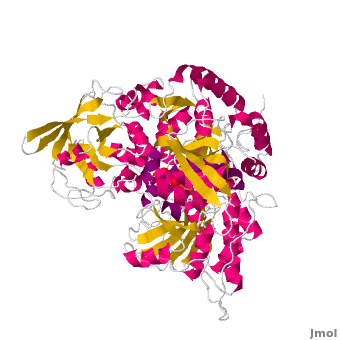Aconitase
From Proteopedia
(Difference between revisions)
(→Catalytic mechanism of mitochondrial ACO) |
(ref) |
||
| Line 6: | Line 6: | ||
== Catalytic mechanism of mitochondrial ACO == | == Catalytic mechanism of mitochondrial ACO == | ||
| - | <applet load=7acn scene='Aconitase/7acn-sf4/1' size='400' frame='true' align='left' caption="Mitochondrial aconitase from pig, PDB [[7acn]]." />Both mAc and cAc are quite similar in their ACO function. Studies, however, concentrated on <scene name='Aconitase/7acn-sf4/1'>the mitochondrial ACO</scene>. ACO is an excellent system for understanding the role of iron-sulfur-clusters in catalysis. The <scene name='Aconitase/7acn-sf4-3cys/1'>(4Fe-4S) cofactor is held in place</scene> by three sulfur atoms belonging to the cysteins-385, -448, and -451 <scene name='Aconitase/7acn-sf4-3cys-solo/1'>which are bound to three of the four</scene> cluster iron atoms. The fourth, Fe4, is free to bind; it can be four-, five-, or six-coordinate, but is constrained to bond to three sulfur atoms of the (4Fe-4S)-cluster with | + | <applet load=7acn scene='Aconitase/7acn-sf4/1' size='400' frame='true' align='left' caption="Mitochondrial aconitase from pig, PDB [[7acn]]." />Both mAc and cAc are quite similar in their ACO function. Studies, however, concentrated on <scene name='Aconitase/7acn-sf4/1'>the mitochondrial ACO</scene>. ACO is an excellent system for understanding the role of iron-sulfur-clusters in catalysis. The <scene name='Aconitase/7acn-sf4-3cys/1'>(4Fe-4S) cofactor is held in place</scene> by three sulfur atoms belonging to the cysteins-385, -448, and -451 <scene name='Aconitase/7acn-sf4-3cys-solo/1'>which are bound to three of the four</scene> cluster iron atoms. The fourth, Fe4, is free to bind; it can be four-, five-, or six-coordinate, but is constrained to bond to three sulfur atoms of the (4Fe-4S)-cluster with tetrahedral geometry. Thus, Fe4 is free to bind one, two, or three partners, in this reaction always oxygen atoms belonging to other molecules. As Fe4 is not bound very fast to the cluster, it moves quite a bit around in the process of bonding and debonding.<ref>PMID:8151704</ref> |
<!--It is clear that, in order to synthesize L-isocitrate, stereoselective catalysis must occur.--> | <!--It is clear that, in order to synthesize L-isocitrate, stereoselective catalysis must occur.--> | ||
| Line 36: | Line 36: | ||
*[[8acn]] - mAc (''Sus scrofa'') with nitroisocitrate | *[[8acn]] - mAc (''Sus scrofa'') with nitroisocitrate | ||
--> | --> | ||
| - | == | + | == References == |
| + | <references /> | ||
| + | |||
| + | == External links == | ||
*[http://pdb.rcsb.org/pdb/static.do?p=education_discussion/molecule_of_the_month/pdb89_1.html Molecule of the Month: Aconitase and Iron Regulatory Protein 1] | *[http://pdb.rcsb.org/pdb/static.do?p=education_discussion/molecule_of_the_month/pdb89_1.html Molecule of the Month: Aconitase and Iron Regulatory Protein 1] | ||
*[http://en.wikipedia.org/wiki/Aconitase Aconitase at Wikipedia] | *[http://en.wikipedia.org/wiki/Aconitase Aconitase at Wikipedia] | ||
Revision as of 17:04, 20 February 2009
Aconitase (ACO) is an enzymatic domain that confers the ability to catalyse the equilibrium
- citrate = aconitate + H2O = L-isocitrate
This reaction is part of the citrate (TCA-, Krebs-)cycle.
In most organims, there is a cytosolic enzyme with an ACO domain (cAc), and in eukaryotes, a second copy of it was introduced with mitochondria (mAc). Plants developed even more copies in mitochondria.
Contents |
Catalytic mechanism of mitochondrial ACO
|
Cytosolic aconitase and its other function
References
- ↑ Lauble H, Kennedy MC, Beinert H, Stout CD. Crystal structures of aconitase with trans-aconitate and nitrocitrate bound. J Mol Biol. 1994 Apr 8;237(4):437-51. PMID:8151704 doi:http://dx.doi.org/10.1006/jmbi.1994.1246
External links
Proteopedia Page Contributors and Editors (what is this?)
Michal Harel, Alexander Berchansky, Ralf Stephan, David Canner, Joel L. Sussman, Jaime Prilusky, Anthony Noles, Angel Herraez, Eran Hodis

